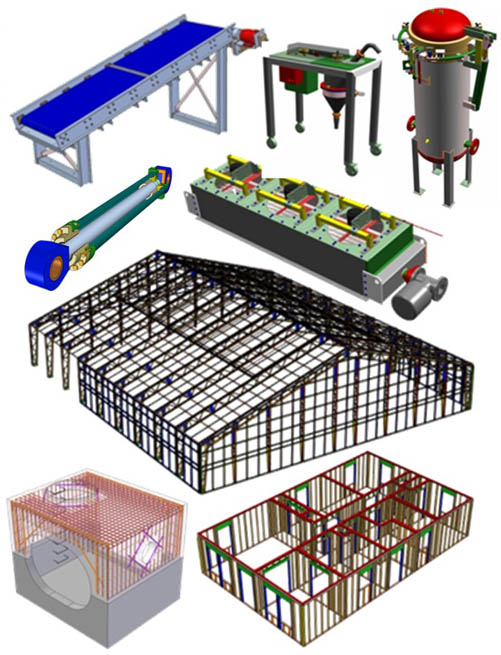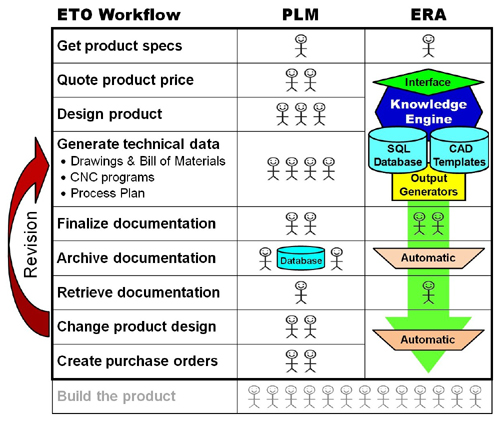
Renew ETO manufacturing profitability with automated PLM
Staff
General DPNProduct life-cycle management (PLM) technology enables enterprise-wide visibility of engineering documentation in an industrial operation.
PLM is applied successfully in repetitive manufacturing of large assemblies like cars and airplanes where thousands of components must be designed, revised, tracked, purchased or produced, and serviced after delivery.
Figure 1 below depicts several products which are different every time they’re built, i.e. they’re custom items. Engineer-to-order (ETO) manufacturers haven’t seen the cost-saving benefits of PLM. Why? There’s a key difference between repetitive and ETO production – the engineering ‘content’ of a company’s deliverables. For repetitive manufacturers the cost of design and technical data management (typically less than 5% of product cost) is amortized over large production quantities.

Figure 1: Engineer-to-order products require unique designs for every quote and production run.
In contrast, ETO companies can easily incur a 30% burden for design of one-off complex items to meet unique customer specifications. With today’s slim profit margins, ETO manufacturers don’t have the luxury of extra manpower to submit and manage PLM content for every new product design, so attempts to implement the technology have been disappointing. But it’s conventional PLM that hasn’t met expectations in custom manufacturing.
{mospagebreak}
What’s beyond conventional PLM? – automated PLM, also known as engineering resource automation or ERA. ERA is an innovative combination of several software technologies driven by a knowledge engine. Figure 2 below compares the old and new philosophies for generating and managing volumes of technical data in an engineer-to-order environment.
The effort to prepare instructions to drive production activity (ETO Workflow) is knowledge work requiring technical skills. In the PLM column, engineers and technologists work with CAD and CAM systems, spreadsheets, word processing, and perhaps some internal software tools for critical calculations. Engineering represents a workflow bottleneck because the all-important product design is still developed by repetitive interactive CAD methods. Moreover, if the company uses 2D drafting, technical documentation will likely contain errors because it’s difficult for humans to track all the 3D relationships between different parts in a complex assembly. PLM offers little to reduce the workload associated with preparing for a production run.

Figure 2: Staffing requirements for PLM versus ERA
The ERA column represents the new way of delivering technical documentation automatically. Using the Lean practice of value stream mapping, a knowledge engine is programmed with all the decisions engineers make to develop a viable custom product design. The knowledge engine references a SQL database of commercial standards and a collection of modifiable 3D parametric solid CAD template components. Product specifications are submitted to the ERA system which automatically generates a precise, toleranced digital prototype of the proposed product.
Embedded with Bill of Material attributes, this product representation is referenced to generate associative drawings with 3D relationships intact. If the design needs iteration to reflect a change in customer requirements, the engine processes a new set of inputs and in minutes a revised prototype is generated and archived for retrieval anywhere. Even purchase orders can be generated automatically to fulfill the build requirements for a production run.
Note how the PLM column relies on many humans to deliver a design and document it. In the ERA column, technology does the same thing but far faster with fewer participants. If an ERA-generated design exhibits errors, the errors can be eliminated by modifying the knowledge engine algorithms.
Conventional PLM technology merely provides a ‘vault’ in which to archive engineering documentation whereas ERA generates and stores all the design detail automatically. ERA still needs engineers to check the knowledge engine’s output and tweak designs to accommodate unusual custom features. This work can be completed rapidly with interactive 3D CAD tools using a near-complete digital prototype as the starting point.
Custom manufacturing is highly dependent on the costly knowledge work performed by skilled employees. ERA minimizes a company’s internal demand for technical skills, thereby enabling a manufacturer to grow profitably with a core of competent engineers managing a programmable knowledge engine. Now we have the capacity to reduce engineering content in custom products from 30% to about 10% – a critical improvement for manufacturers struggling to survive in today’s hyper-competitive marketplace.
Gord Hobbs, P.Eng., is co-founder of Logicap Engineering Corp., a Cambridge, ON-based engineering software firm that helps manufacturers overcome productivity obstacles with its unique solution to automating complex technical processes. He can be contacted at (519) 489-7222 x216 or ghobbs@logicap.ca.
